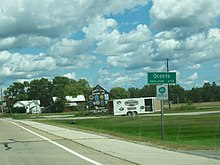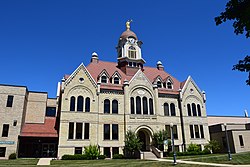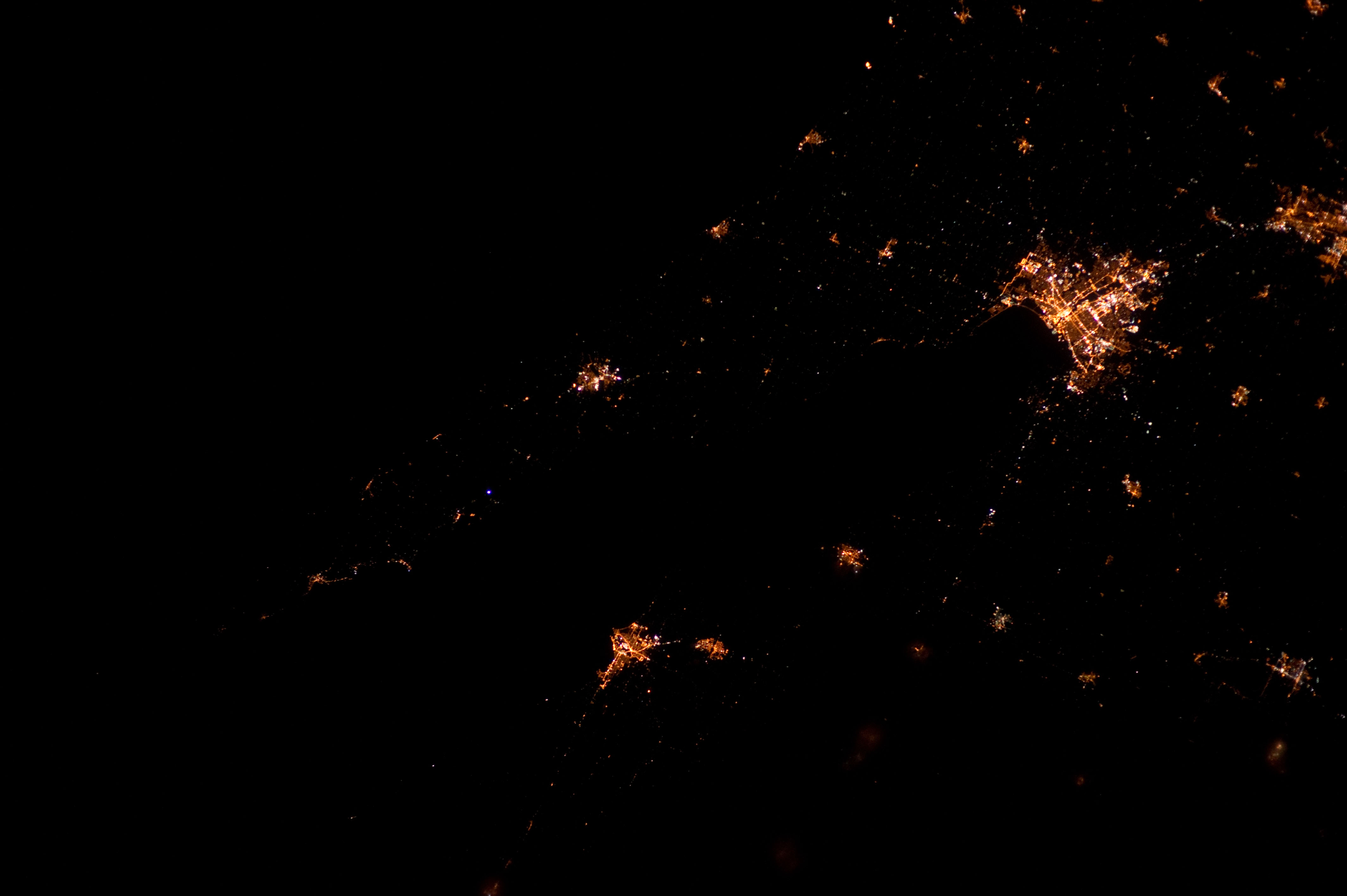|
Oconto, Wisconsin
Oconto is a city and county seat of Oconto County, Wisconsin, United States. The population was 4,609 at the 2020 census. It is part of the Green Bay Metropolitan Statistical Area. The city is located partially within the town of Oconto. HistoryOconto is home to Copper Culture State Park, which has remains dated to around 5000-6000 B.C. It is a burial ground of the Copper Culture Indians. This burial ground is considered to be the oldest cemetery in Wisconsin and one of the oldest in the nation.[3] Their descendants include the Menominee, who have lived here for thousands of years. The first Europeans to come to the area were the French, who considered it to be part of New France. The French Jesuit, Roman Catholic priest, and missionary, Father Claude-Jean Allouez said the first Mass in Oconto on December 3, 1669.[4] The Menominee living here began participating in the fur trade network and converting to Christianity.[3] This area was included in the land ceded by the Menominee to the United States government in the 1836 Treaty of the Cedars. In this treaty, the Menominee ceded over four million acres of land after years of negotiations about how to accommodate the Oneida, Stockbridge-Munsee, and Brothertown peoples who were being removed from New York to Wisconsin.[5] Following the treaty, the land became officially available for American settlement, although soldiers and lumberers had already been here for some time. The same year the Treaty of the Cedars was signed, George Lurwick bought a home and sawmill along the Oconto River, becoming the town's first private land owner now that the land had been sold to the United States.[3] The city of Oconto was incorporated in 1869.[6] The city took its name from the nearby Oconto River.[7] The name Okāqtow is a Menominee name meaning "the place of the pike", one of several pike-related place-names in the area.[8] The first Christian Science church in the world was erected in 1886 in Oconto and still stands at the corner of Main Street and Chicago Street. The land was donated by Henry (1837–1904) and Victoria Sargent (1848–1930).[9][10][11][12] In 1891, the city hosted minor league baseball when the Oconto Log Drivers became charter members of the Wisconsin State League.[13][14][15][16] The league began play on May 14, 1891 and the Log Drivers did not return after the first league season.[17] In the summer of 1952, during a two-day period, an estimated 175,000,000 leopard frogs emerged from nearby marshes and enveloped the town. The water level of Lake Michigan rose in the spring, flooding the wetlands. The frogs laid their eggs, and when the lake level receded with the heat of summer, most of the eggs would die. However, in 1952, Lake Michigan remained high, and a huge number of frog eggs grew into live amphibians.[18] GeographyOconto is located at 44°53′N 87°52′W / 44.883°N 87.867°W (44.8877, -87.8704).[19] According to the United States Census Bureau, the city has a total area of 7.14 square miles (18.49 km2), of which, 6.79 square miles (17.59 km2) is land and 0.35 square miles (0.91 km2) is water.[20] Oconto is located at the mouth of the Oconto River, which feeds into Lake Michigan. Climate
Demographics
The table with historical census data[24] indicates that the population has remained relatively flat throughout the 20th century. 2020 censusAs of the census of 2020,[2] the population was 4,609. The population density was 679.3 inhabitants per square mile (262.3/km2). There were 2,175 housing units at an average density of 320.6 per square mile (123.8/km2). The racial makeup of the city was 91.8% White, 2.1% Native American, 0.5% Black or African American, 0.4% Asian, 0.7% from other races, and 4.5% from two or more races. Ethnically, the population was 3.1% Hispanic or Latino of any race. 2010 censusAs of the census[25] of 2010, there were 4,513 people, 1,872 households, and 1,172 families residing in the city. The population density was 657.9 inhabitants per square mile (254.0/km2). There were 2,094 housing units at an average density of 305.2 per square mile (117.8/km2). The racial makeup of the city was 96.4% White, 0.7% African American, 1.1% Native American, 0.4% Asian, 0.4% from other races, and 1.2% from two or more races. Hispanic or Latino people of any race were 2.4% of the population. There were 1,872 households, of which 30.0% had children under the age of 18 living with them, 45.1% were married couples living together, 11.4% had a female householder with no husband present, 6.1% had a male householder with no wife present, and 37.4% were non-families. 32.2% of all households were made up of individuals, and 15.1% had someone living alone who was 65 years of age or older. The average household size was 2.35 and the average family size was 2.95. The median age in the city was 39.6 years. 23.4% of residents were under the age of 18; 8.9% were between the ages of 18 and 24; 24.5% were from 25 to 44; 27.3% were from 45 to 64; and 15.8% were 65 years of age or older. The gender makeup of the city was 49.7% male and 50.3% female. 2000 censusAs of the census[26] of 2000, there were 4,708 people, 1,870 households, and 1,221 families residing in the city. The population density was 683.7 people per square mile (263.8/km2). There were 2,040 housing units at an average density of 296.2 per square mile (114.3/km2). The racial makeup of the city was 97.79% White, 0.02% Black or African American, 0.85% Native American, 0.17% Asian, 0.06% Pacific Islander, 0.21% from other races, and 0.89% from two or more races. 0.79% of the population were Hispanic or Latino of any race. There were 1,870 households, out of which 33.2% had children under the age of 18 living with them, 49.1% were married couples living together, 11.5% had a female householder with no husband present, and 34.7% were non-families. 29.3% of all households were made up of individuals, and 15.0% had someone living alone who was 65 years of age or older. The average household size was 2.44 and the average family size was 2.99. In the city, the population was spread out, with 25.8% under the age of 18, 8.8% from 18 to 24, 27.8% from 25 to 44, 21.0% from 45 to 64, and 16.7% who were 65 years of age or older. The median age was 37 years. For every 100 females, there were 92.2 males. For every 100 females age 18 and over, there were 89.0 males. The median income for a household in the city was $34,589, and the median income for a family was $43,676. Males had a median income of $27,455 versus $22,083 for females. The per capita income for the city was $20,717. About 5.2% of families and 8.8% of the population were below the poverty line, including 9.6% of those under age 18 and 10.5% of those age 65 or over. Education  The following schools are located in Oconto:[27]
TransportationMajor highways
AirportJ. Douglas Bake Memorial Airport (KOCQ) serves the city and surrounding communities. Notable businesses
Notable people
References
External linksWikimedia Commons has media related to Oconto, Wisconsin. |
||||||||||||||||||||||||||||||||||||||||||||||||||||||||||||||||||||||||||||||||||||||||||||||||||||||||||||||||||||||||||||||||||||||||||||||||||||||||||||||||||||||||||||||||||||||||||||||||||||||||||||||||||||||||||||||||||||||||||||||||||||||||||||||||||||||||||||||||||||||||||||||||||||




